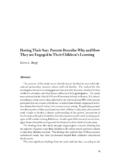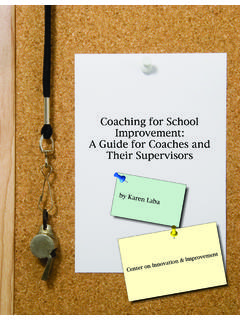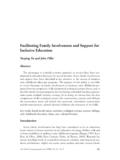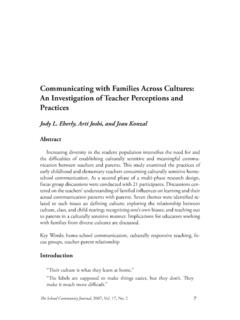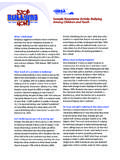Transcription of Parental Involvement in Education Among Low- …
1 43 The School Community Journal, Volume 16, Number 1 Parental Involvement in Education Among Low-Income Families: A Case StudyJane Graves SmithAbstractIn order to explore Parental Involvement Among low-income families, a case study was conducted at a public elementary school in the Pacific Northwest. In 2002, a new school replaced an outdated structure. During the planning stage for the new school, community members and agency professionals, along with educators, developed and implemented programs to both support families and engage them in their children s Education . Utilizing qualitative research meth-ods, interviews, observations, and document reviews were conducted with the intention of investigating the impact of efforts undertaken to involve parents at the new school.
2 The study found that the development and implementation of intentional Parental Involvement strategies positively influenced the level of Parental Involvement . In addition, participants perceived numerous ben-efits to students and families resulting from strategies implemented and the related Involvement . Parental Involvement strategies also influenced educator s perceptions of acceptable Parental Involvement behaviors, with interviewees recognizing a broad array of behaviors as Involvement in Words: Parental Involvement , low-income, school-community relations, achievement gapIntroductionThe purpose of this study was to examine the phenomenon of Parental in-volvement in a low-income school created with Parental Involvement in mind.
3 THE SCHOOL COMMUNITY JOURNAL44In order to explore Parental Involvement Among low-income families, a case study was conducted in March of 2004 at what became known as Clark El-ementary (pseudonym), a public elementary school in the Pacific Northwest. After two academic years at the new site, an investigation of the impact of those efforts could be StatementIn their search for methods to improve academic performance, educational researchers and practitioners have advanced policies designed to promote pa-rental Involvement in children s Education (Abrams & Gibbs, 2002). Teachers and school administrators encourage parents to support their children s aca-demic pursuits at home, as well as in the classroom.
4 Researchers continue to find evidence that higher levels of Involvement by parents are related to aca-demic success for students (Epstein, 2001). According to Lareau (1987), Parental Involvement is seen as an integra-tion of home and school. This pratice encourages parents to participate in the life of the school, as well as attend to the learning of their children at home (Epstein, Sanders, Simon, Salinas, Jansorn, & Van Voorhis, 2002). Many edu-cators believe that creating a community of families, students, teachers, and school administrators provides additional support for children s learning. Fur-ther evidence suggests that academic success may be predicted by the quality of these connections (Booth & Dunn, 1996).
5 The promotion of Parental Involvement to increase academic success raises issues of equity, since rates of Parental Involvement are significantly higher Among middle- and upper-class parents than in low-income families (de Car-valho, 2001). Researchers agree that rates of Parental Involvement are lower in low-income communities than in higher income schools (Abrams & Gibbs, 2002; Epstein, 1995; Lareau, 2000; O Connor, 2001). Therefore, low-income children, with less involved parents, often experience fewer of the academic benefits than children coming from higher income homes. It follows, then, that children of higher income families are receiving more of the academic and attitudinal benefits of Parental Involvement than low-income children.
6 Children of low socioeconomic status (SES) are at risk for lower academic achievement (McLloyd, 1990). For these children, rather than acting as a ben-efit, the lack of Involvement by their parents only leaves them farther behind their higher income counterparts. School personnel continue to request Parental Involvement without taking into account the SES of the family (Lareau, 2000). Policies have been created at the local district level, as well as state and federal levels, which ignore the Involvement OF LOW-INCOME FAMILIES45particular needs of underrepresented groups (Delgado-Gaitan, 1991). Instead of raising academic performance for low-income students, too often Parental Involvement policies only serve to widen the achievement gap (de Carvalho, 2001) and create barriers between schools and families (Delgado-Gaitan).
7 The most widely accepted definition of Parental Involvement focuses on behaviors that can more easily be accomplished by middle- and upper-income parents (Mapp, 2003). The current Parental Involvement policies, built on the accepted definition, disregard the needs of low-income children and their families which further burdens children who are already falling behind aca-demically (de Carvalho, 2001; Delgado-Gaitan, 1991; Mapp). A small number of researchers have investigated the challenges encountered when low-income parents attempt to become involved and have also provided a number of recommendations for enhancing Involvement for these families (Comer, Ben-Avie, Haynes, & Joyner, 1999; Lareau, 2000; O Connor, 2001).
8 These researchers have called for further research regarding involving parents in their children s Education Among underrepresented groups. In addition, in an annual synthesis of Parental Involvement literature, Jordan, Orozco, and Averett (2001) reported that educators are attempting to create partnerships with families without adequate research-based knowledge ( p. 1) to support their efforts. A case study has been conducted in an attempt to answer calls for further knowledge and understanding of Parental Involvement Among low-income families. MethodologyIn September of 2002, students and staff moved from an aging, out-of-date structure into a new building developed by a group of committed individu-als, the Clark Advisory Committee, from many parts of the community.
9 At its inception, those envisioning a new Clark Elementary School considered the Involvement of parents as much more than help in the classroom and super-visors of homework. The physical, emotional, social, and intellectual needs of the families were also considered, and efforts were created intended to meet those needs. Parents were intentionally considered in two distinct ways. First, the indi-viduals involved in the design of the new building considered the needs of the mostly low-income neighborhood residents. The Clark Advisory Committee created and implemented strategies in an effort to meet those perceived needs. Second, with a belief in the benefits of Parental Involvement in Education , the Clark Advisory Committee also created and implemented strategies designed to enhance the Involvement of parents at Clark.
10 The consideration of parents is THE SCHOOL COMMUNITY JOURNAL46apparent from the initial conceptualizations of program development through the implementation of those programs until today, years later, when the early outcomes of those efforts are becoming SettingClark Elementary School was situated beside a city park in a small commu-nity surrounded by large industrial complexes. The majority of residents in the neighborhood were low-income, with the local housing authority providing a high percentage of residences at a subsidized rate. In October of 2003, 99% of the 182 students were eligible for free lunch, qualifying the school to receive Title I funds. During the 2003-2004 school year, 5% of the students were American Indian, 3% of the students were Asian, 7% were Black, 19% were Hispanic, and 67% were White.
